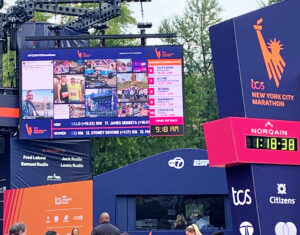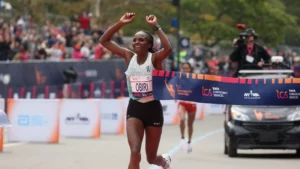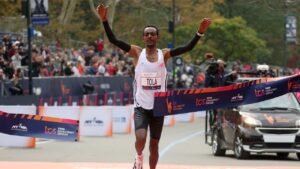Cellular Technology Supercharges Coverage Of The NYC Marathon
CP Communications streamlines its signal infrastructure for the great race
Story Highlights
This year’s NYC Marathon (Sunday, Nov. 5 on ABC and ESPN networks) saw nearly 50,000 runners tee up in Fort Wadsworth, the park at the foot of the Verrazano Narrows Bridge in Staten Island before setting out on a 26-mile run through all five of the city’s boroughs. The race, which was first run in 1970, is massive; not surprisingly, so is the infrastructure needed to capture the scale of the event for broadcast, although this year there were some cellular assists to make the huge production slightly less challenging.
ESPN and WABC broadcast to more than 534 million homes around the world in 206 countries and territories through various international broadcast partners, including ABC7/WABC-TV in the New York City area and ESPN2 across the United States. WABC-TV and ESPN2 have been home to the broadcast of the world’s biggest and boldest marathon since 2013.
Several hundred personnel were deployed by CP Communications, ESPN, and other systems suppliers to cover the 6-hour-plus race, whose numerous categories include men, women, and non-binary runners along with wheelchairs and handcycles.
“It’s a 4 a.m. call and the feeds stay hot until 4 p.m. streaming on the RoadRunners app,” says Brian Ready, system and comms engineer for CP. “It’s a long day, but it really started back in July when [CP senior tech manager] Frank Rafka started planning for it.”
Officially the “TCS New York City Marathon,” the race coverage began at the Staten Island starting line and ended near Central Park’s Tavern on the Green in Manhattan. The broadcast, produced by Film 45 in their second year on this event, partnered with CP Communications for comms and RF, and NEP for mobile units, with NEP Red and Black deployed in the compound on Central Park West between W 67th and W 70th streets, while the race itself is tracked by four “smart” cars for in-race announcers, and three e-bikes, all fitted with cameras and microphones and three with roving-reporter talent. Ready says the large crew and gear deployments reflect the international interest the marathon attracts, which is addressed through a dedicated world feed and streaming. Specific cars and bikes are assigned to various subgroups within the race, such as men’s, women’s, and wheelchair pack leaders. Three car and all e-bike cameras were Sony 1500 portables; one car was equipped with a Sony HDC- P1 on a Condor black arm three-axis stabilizing system.
Locations, Locations, Locations
Supporting that were three remote cameras sites: Fourth Ave. in Brooklyn, with a jib camera; First Ave. on the Manhattan side of the Ed Koch Queensboro Bridge; and the little sliver of the Bronx the race passes through called Mile 20, with jib and handheld cameras, all Sony 1500s. These disparate sites, as well as much of the rest of the infrastructure, were connected over an IP infrastructure provided largely by Verizon.
“Verizon provides us internet lines at all sites, and then we create pipelines through our routers and our switches to bring all of that information back to our core at the finish line,” says Ready. “The start line has [NEP’s] NCP 2 there providing cameras and some audio, and that truck is, from an intercom perspective, trunked into our truck as well NEP’s. So we trunk all the intercoms together, so that PL is available everywhere. And then through our pipelines, we traverse the cameras and mix-minuses. There are wireless mics that aren’t at the start line, so the start-line production is actually done from the finish line via CP’s pipelines.”
At key waypoints, SMT (SportsMEDIA Technology) had 18 LED displays set up across the grounds and course, displaying content unique to various locations, including the Javits Center, start line, and finish line. Five on-course displays were located at miles 8, 16, 20, 23 and 26. In addition, two LED track boards greeted runners with SMT-produced race content. A 50-foot ribbon board was also suspended from the photo bridge and displayed runner times for each of the waves.
Key elements of SMT’s broadcast contribution included race crawls featuring lower-screen tombstones displaying the current place of elite men and women, wheelchair athletes, and participants’ names as they cross the finish line; pointer graphics identifying relevant runners at points along with course; and talent prompters, delivering historical and relevant data to commentators and production teams.
Comms
Comms for the event used a combination of RTS trunked together cross all mobile units and CP’s proprietary private cellular LTE and Green-GO Digital intercoms (similar to that used by NFL coaches), as well as a Unity Intercom cellular system for headset-wearing, bike-mounted spotters who stayed with the respective sub-category leaders and provided constant feedback to production. The LTE system utilized the CBRS (Citizens Broadband Radio Service) 3.5-GHz spectrum the FCC (shared with the Department of the Navy) provides to enable enterprises to build their own private 4G/5G networks.
“So we have to do a little work ahead of time and there’s some coordination involved,” he explains. “There’s a thing called the SAS, which is a spectrum assignment system, controlled by Google and Federated Wireless, the two major players when it comes to CBRS, that we have to log into that and tell them that who we are, where we are, what we want to do. We have to give them information in terms of the GPS coordinates of all of our cell nodes, as well as heights of the antennas. There’s a lot of front-end work that has to be done. The CBRS also helped us augment the video portion of it, because it’s our own private LTE network and we put proprietary SIM cards and all of our bonded cellular units, which is what we utilize throughout the course to bring back all the video . Those units have a SIM card slot specifically in them designed for CBRS.
The CBRS was particularly useful on the 4,260-foot-long Verrazano Narrows Bridge, where cellular coverage is notoriously spotty.
“The very start of the bridge is in a park, which has very limited coverage to begin with, and then adding 30 to 50,000 people in the park really and cellular coverage really starts to suffer,” he says. “So we utilize the CBRS to keep us out of the congestion and help us augment that as well as bring a portion of it up onto the bridge, because we really don’t get really good cell coverage until we crest the middle of the bridge and start to see Brooklyn. Once you start to see Brooklyn, you get much better cell coverage.”
Further complicating the intercom landscape is the fact that Marathon-sponsoring organization the Road Runners Club uses a Clear-Com FreeSpeak system at the start and finish lines, which occupies much of the 1.9-GHz DECT band there, while the timing and scoring system are in the spread-spectrum 900-MHz band.
“So that limits our crew comm deployment, yet everybody wants multiple channels, so that alone limits which system you can pick,” he says. “By going into CBRS, it’s our own private cellular network and nobody else has access to it but us. So it helped us not only on the intercom side, but also on the video side as well.”
Sounds Of The City
Audio capture along the marathon route was equally diverse. Talent in the smart cars wore Sennheiser MD207 headset microphones, brought back via the cellular network as an embedded channel in the bonded cellular device. And within that an IFB return for their mix-minus coming back from the finish line production. The same arrangement was at each of the three remote sites throughout the city, all of which had reporters throughout the day. So those reporters’ wireless mics were embedded with the video brought back to the finish line.
Ambient sound was captured using the mics mounted on all of the handheld and jib cameras, with the audio embedded with their video. And it was very New York ambient sound: Ready described various noises and music particular to different neighborhoods, some of which had DJs or bands set up.
“Some of them are just general crowd noise, but some people have cowbells, some people have air horns — every neighborhood you run through is different,” he says. “So it’s pretty neat to see and hear a lot of the neighborhood culture come out as they run through the diversity of New York.”
The wheelchair and hand cycle races especially benefitted from the use of the e-bikes — the first time they’ve been used for this event’s broadcast — because of their relative silence.
“The E-bikes make very little to no noise, so a lot of time you could actually hear the wheelchair racers very well — you actually heard more of the NYPD motorcycles than you did have our e-bikes,” he says. “The [wheelchair racers] have a protective little piece inside their glove that allows them to grip the wheel and give propel themselves and you could actually hear them grabbing the wheel. It was pretty neat.”
Streamlined Production
Ready says it’s a grueling task to cover a 26-plus-mile-ling sports event for television, to keep the narrative clear while conveying its scope. In this sixth year that CP has done it, though, he says the shift from microwave to bonded cellular as the signal carrier made a huge difference.
“We used to have a crew of a hundred-plus people just on the CP side, because when we used to do a traditional microwave, we had multiple receive sites throughout the city that we would then have video links set up between the sites or internet connectivity, and there’s a variety of complicated ways to bring all that information back to the finish line,” he says. “But as time has gone on, the cellular network has been so enhanced that we’ve been able to take advantage of the deployment that the cellular providers have. Because now I don’t have a rooftop rental and I don’t have the insurance liability of putting multiple people up on a roof. And then set-up time where we used to have to go in a week ahead of time just to get up on the rooftop, get the equipment up there, get all the links in place, get all the fiber optic connectivity — if we were utilizing a separate microwave system to traverse the city, there would have been a lot of different things that we used to have to do. And now it certainly has been simplified. Due to the demand of everybody wanting more content, faster content, and having to provide their own content, we’ve been able to utilize the bonded cellular network to accomplish a lot more with a lot less.”




